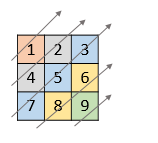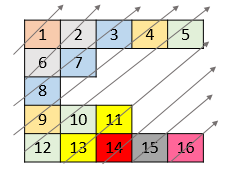Given a list of lists of integers, nums, return all elements of nums in diagonal order as shown in the below images.
Example 1:
Input: nums = [[1,2,3],[4,5,6],[7,8,9]] Output: [1,4,2,7,5,3,8,6,9]
Example 2:
Input: nums = [[1,2,3,4,5],[6,7],[8],[9,10,11],[12,13,14,15,16]] Output: [1,6,2,8,7,3,9,4,12,10,5,13,11,14,15,16]
Example 3:
Input: nums = [[1,2,3],[4],[5,6,7],[8],[9,10,11]] Output: [1,4,2,5,3,8,6,9,7,10,11]
Example 4:
Input: nums = [[1,2,3,4,5,6]] Output: [1,2,3,4,5,6]
Constraints:
1 <= nums.length <= 10^51 <= nums[i].length <= 10^51 <= nums[i][j] <= 10^9- There at most
10^5elements innums.

